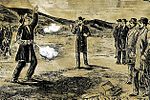David C. Broderick
1820 births1859 deaths19th-century American lawyers19th-century American legislatorsAbolitionists from California ... and 14 more
American people of Irish descentAmerican politicians killed in duelsBurials at Cypress Lawn Memorial ParkBurials at Laurel Hill Cemetery (San Francisco)Daly City, CaliforniaDeaths by firearm in CaliforniaDemocratic Party California state senatorsDemocratic Party United States senators from CaliforniaLawyers from New York CityLieutenant Governors of CaliforniaNew York (state) DemocratsPeople of the California Gold RushPoliticians from New York CityPoliticians from Washington, D.C.

David Colbreth Broderick (February 4, 1820 – September 16, 1859) was an attorney and politician, elected by the legislature as Democratic U.S. Senator from California. Born in Washington, DC, to Irish immigrant parents, he lived in New York until moving to California during the Gold Rush. He was a first cousin of politicians Andrew Kennedy of Indiana and Case Broderick of Kansas. At age 39, Broderick was fatally wounded in a duel with a one-time friend.
Excerpt from the Wikipedia article David C. Broderick (License: CC BY-SA 3.0, Authors, Images).David C. Broderick
Lake Merced Hills Community Center Access Stairs, San Francisco
Geographical coordinates (GPS) Address Nearby Places Show on map
Geographical coordinates (GPS)
| Latitude | Longitude |
|---|---|
| N 37.7081 ° | E -122.4842 ° |
Address
Broderick-Terry Duel
Lake Merced Hills Community Center Access Stairs
94132 San Francisco
California, United States
Open on Google Maps



